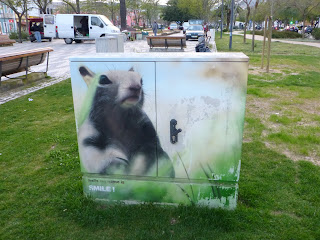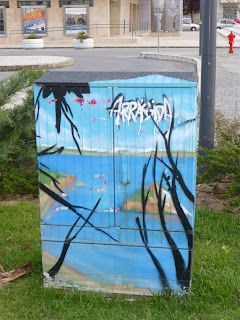 |
| The beautiful fruit market of Setubal |
The ECS closed with a dinner and dancing yesterday evening and many scientists forgot to go to bed.
Here I will just add a few words to give some more
background to the ECS award and its awarding: When Peter Evans spoke yesterday
about Mandy McMath, after whom the ECS conservation award has now been named,
he spoke of her great and highly supportive influence over many of us.
Later, after the conference had closed, someone commented to
me that sometimes people were more influential after their deaths, suggesting
that this might be the case for Mandy. I
guess this may reflect the fact that not everyone in the marine mammal world,
or those gathered at the ECS, knew her. So, for those that did not here is a
link to something I wrote for the WDCS website to mark her passing: HERE. This
also links to a little bit of film where you can also see her.
Whilst Peter’s speech brought many tears from many of her
friends, I am sure she would not have wanted people to be sad on her account
and that she would have been very pleased with the choice of Erich Hoyt as the
first person to receive the award now named after her.
One of the more amusing (and nerve-wracking) elements to the
awards ceremony was the need to track Erich Hoyt and make sure that he was in
the conference chamber for the ceremony.
Late in the morning it was noticed that he was missing. He had
obviously quietly left the room and the word quickly went around that we had
lost him. The fear was that he might have left for the afternoon to catch up on
urgent emails, improve a manuscript with a deadline, gone jogging or
something else. Soon it became clear that he was nowhere in the conference
centre and a search team composed of the WDC delegates, the ECS conservation award committee
and others started to spread out from the conference centre in an attempt to find it. It
was agreed that he should be told (if we could contact him) that the keynote
speakers (of which he was one of three) were required to be at the closing ceremony
where they would be thanked. Only Mike Tetley proved to have Erich's mobile number, so this
message was sent via him.
After half an hour or so Erich was located, by the president of
the ECS, in a little café on the far side of main road outside the conference
centre. He was having lunch with some of his Russian colleagues, unaware of the concern he was generating. The message was
delivered that he was needed in the closing conference sesson and, from here on in, a team carefully monitored his movements.
Erich returned to the conference hall after the AGM had concluded
but then, come the afternoon coffee break, he shot outside again. At this point
I was the person monitoring his movements and using all the stealth that I
posses (i.e. not very much) followed him discretely through the crowd of
smokers and coffee addicts taking the air. He took shelter in a window alcove
on the further corner of the building chatting to a colleague but this was also a perch from where
he could easily launch himself away from the centre. Fortunately he didn’t, and
as the hour drew near for the awards ceremony. I watched him return to the hall
and descend down stairs into the gentleman’s toilet … from which he did not
return. I had lost him!
One of the Erich monitoring team went to check the toilet.
He was not there. Mild panic now pervaded the group.
But then he was again discovered – having returned from the
washroom via a different set of stairs – getting a coffee in a corner of the
conference centre. Mike was now left to keep an eye on him and I went to the
front of the conference hall to sit and wait for the moment to give the speech.
I was also awaiting a signal that Erich was safely in the chamber.
I did not get this. Instead, Erich – using some of that
special intuitive magic of his - simply wandered into the hall and then came and sat next to me.
(There were a couple of fall-backs if we had lost him for a
third time: firstly I would have filled-in for five minutes or so with an
‘amusing’ lecture on ‘beards’ and, secondly, if he was still missing after
this, we would have announced the award at the conference and actually given it
to him at the dinner and dance scheduled for the evening.)
 |
| Andrew in action. |
I forgot to mention yesterday that Dr Andrew Wright was
given the award for the best student presentation.
And, finally, I promised some days ago to show an example of the monstrous cetaceans of Victorian books, so here is one:
This is an illustration from 'Mammalia: their various forms and habits', adapted from the text of Louis Figuier by E. Percival Wright and published in 1892 by Cassell and Company.
The caption reads 'Dolphins pursuing a boat' and the men on board look like they have pikes to ward off these monsters. Here is a close up of the head:
Would these illustrations in this popular book have helped colour the view of people living in late Victorian Britain towards these animals? It certainly seems likely. Illustrations at this time may have been based on earlier inaccurate drawings of sea monsters and/or studies of decomposed bodies.
Compare this with the very recent images of dolphins in this new fold-out guide published by the Field Studies Council and produced by the excellent natural history illustrator, Lucy Molleson, who was able to base her pictures on many sources, including her own field work on dolphins.
 |
| Cover of 8 page field guide available from FSC |
















































